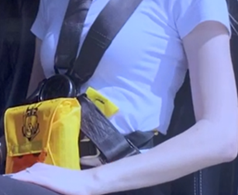Safety Advisory Notice
To aviation research and testing organisations
Research and testing required for fitment of constant wear lifejackets with multipoint seatbelts.
Occupants in helicopter tourism operations worldwide are at risk of increased injury in an accident due to inadvertent incorrect use of seatbelts. There is no guidance available on correct use of constant wear lifejackets with multipoint seatbelts and research and testing is needed.
What happened
On 2 January 2023, while conducting short scenic flights, 2 Eurocopter EC130 B4 helicopters collided midair at the Gold Coast, Queensland. One helicopter proceeded to a controlled landing on a sandbar; the pilot and 2 passengers were seriously injured. The other helicopter was uncontrollable and fell to the edge of the sandbar. Three passengers were seriously injured and the pilot and 3 passengers were fatally injured.
What was identified
Passengers from both helicopters were found to be inadequately restrained from incorrect fitment of their seatbelt. This was due in part to the placement of constant wear lifejackets that were being worn. The ATSB was unable to determine the level of contribution of incorrect restraint to the injuries sustained by the passengers.

Australian regulations for scenic flight operations over water require passengers to be wearing lifejackets in addition to seatbelts in a helicopter. This is to ensure that passengers can access this piece of equipment in a timely manner. To comply with the regulation most operators provide their passengers with pouch style constant wear lifejackets. While these 2 pieces of equipment were commonly used together there was no available guidance about how to integrate them while maintaining their functionality. Manufacturer instructions for fitment of all pouch style constant wear lifejackets requires them to be worn around the waist and positioned at the middle of the body. However, this interferes with the correct fitment of a multipoint seatbelt.
The correct fitment of any seatbelt requires the lap portion to be worn low and tight across the hips. The operator’s ground and flight crew were not aware of how to integrate the constant wear lifejacket with seatbelts without affecting correct fitment of the seatbelt. This led to inadvertent incorrect fitment of passenger seatbelts.
However, no readily available guidance exists from lifejacket manufacturers or regulatory authorities for use by aircraft operators regarding the fitment of multipoint seatbelts with constant wear lifejackets.
Safety advisory notice
AO-2023-001-SAN-002: The ATSB encourages those organisations capable of research to determine a correct method of wearing a constant wear lifejacket with a multipoint seatbelt, while ensuring the correct function of each.
Research and testing required
Having access to a lifejacket in the case of ditching is important and reduces the risk of drowning, which is why the use of a constant wear lifejacket is required for certain overwater operations. However, an occupant must survive the impact and therefore correct fitment of their seatbelt is vital to ensure the restraints and energy attenuating features of seats work as designed.
The ATSB issued AO-2023-001-SAN-001, which provided information on the correct fitment of multipoint restraints and called for guidance to be developed by lifejacket manufacturers and/or certifying authorities. This notice acknowledges that those parties would benefit from research organisations’ investigation and validation so that appropriate guidance on the correct fitment of multipoint restraints and constant wear lifejackets can be developed.
The outcomes of the research and testing will contribute to a solution for the widespread problem of inconsistent and frequently incorrect wearing of seatbelts. Development of guidance and procedures for aircraft operators to correctly integrate constant wear lifejackets with a multipoint seatbelt will benefit passengers across helicopter tourism operations worldwide.
Read more about this ATSB investigation: Midair collision involving Eurocopter EC130 B4, VH-XH9, and Eurocopter EC130 B4, VH-XKQ, Main Beach, Gold Coast, Queensland, on 2 January 2023


